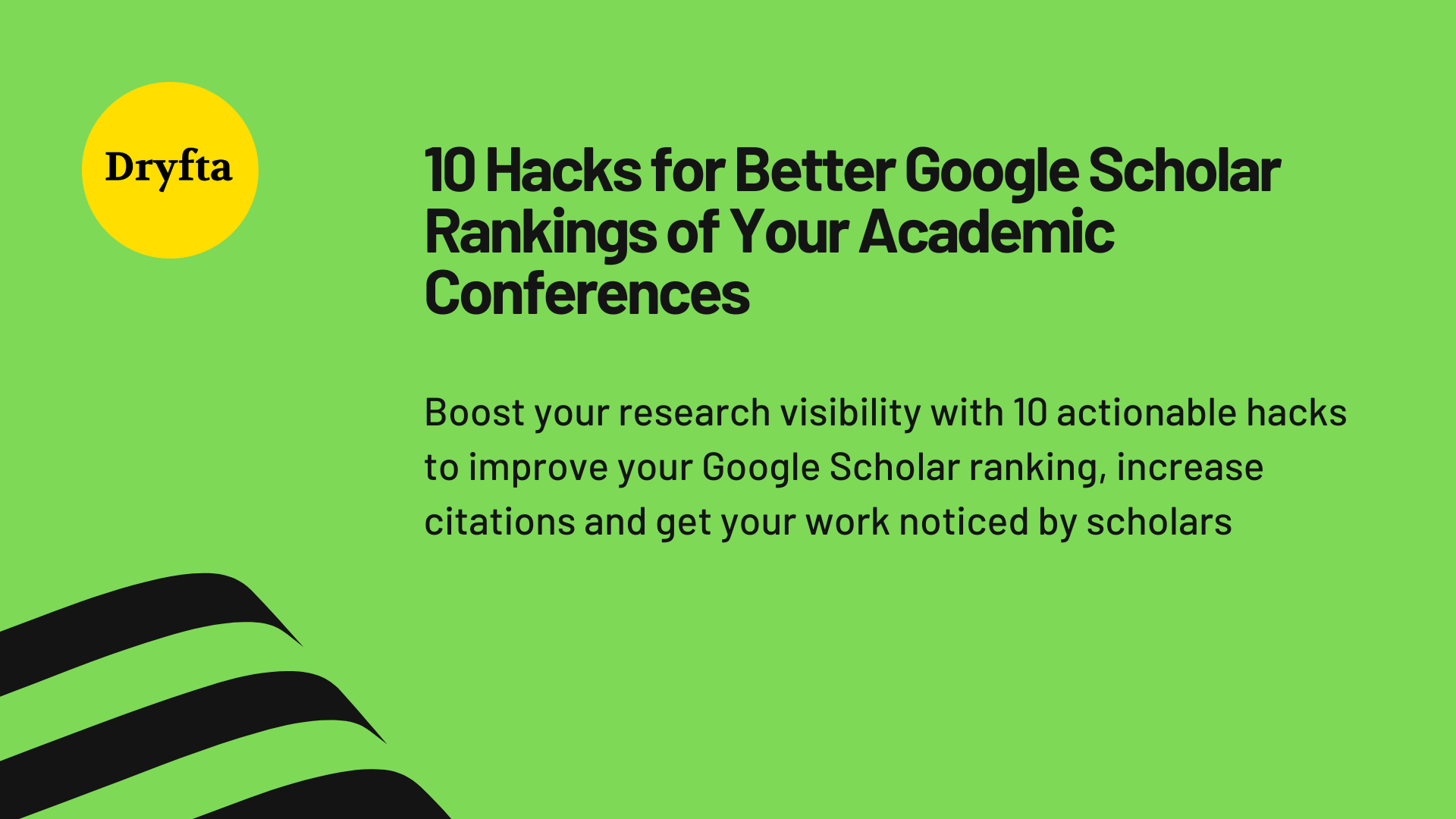
Conference proceedings are a lot like a billboard for your academic community. If they look authoritative and are easy to find, scholars will want to publish with you, too. An incredible platform to build your credibility is Google Scholar.
Google Scholar, if used right, can open up multiple doors for you. But if your conference proceedings don’t show up there, researchers won’t find your work. Period. But if your papers rank high in search results, citations flow in, submission quality goes up and your conference gains the credibility it deserves.
Getting this visibility is the key. A strong Google Scholar presence sets your conference apart and makes researchers want to participate year after year. In fact, they’ll eagerly submit their best work. In this article, we’re letting you in on 10 hacks on how to build that presence. Here’s everything you need to know about creating a Google Scholar footprint that draws researchers in immediately and keeps them coming back.
1. Make Your Metadata Scholar Friendly
Proper metadata is the most important signal of your academic conference‘s legitimacy to Google Scholar. If it’s a confusing mess or missing entirely, the algorithm won’t know what to do with your content. A poorly tagged paper amongst thousands of properly indexed ones gets buried instantly. Similarly, a simple yet often ignored way to outdo competing conferences is to not skimp on technical details. Tag everything correctly and watch the rankings climb.
If your research papers are solid, proper metadata amplifies their discoverability. On the other hand, publishing excellent research with terrible technical implementation can be completely counterproductive.
2. Create a Permanent Home for Your Proceedings
Your conference needs a dedicated website with URLs that never change. Google Scholar trusts content that appears stable and authoritative. Each paper should have its own persistent URL that stays active forever, not just during the conference year.
Don’t make the rookie mistake of taking down your conference site after the event ends. Dead links damage your ranking and frustrate researchers trying to access work they’ve discovered. Keep everything online indefinitely.
3. Put PDFs Front and Center
Google Scholar strongly favors downloadable PDFs. Every paper needs to be available as a direct PDF download from your conference website. Don’t bury the link three clicks deep or hide it behind login screens during the initial indexing period.
The metadata tag should point straight to the file without any redirects or paywalls blocking the crawler. If you must control access later, consider making papers freely available for the first few months as Google Scholar indexes them, then add restrictions if necessary.
Make sure your PDFs contain actual searchable text, not scanned images. Use proper PDF generation tools that preserve the text layer. This makes your content infinitely more accessible to crawlers and dramatically improves how Google Scholar processes and ranks the papers.
4. Structure Your Conference Like a Real Journal
Google Scholar treats conference proceedings more seriously when they look like traditional academic publications. This isn’t about being pretentious. It’s about speaking Google Scholar’s language.
Get an ISSN (International Standard Serial Number) through your national ISSN center. This identifier tells Google Scholar your conference is a legitimate serial publication. Use the same ISSN every year to build recognition over time. Add volume and issue numbers. Include page numbers for each paper. Create a formal table of contents. List your editorial board or program committee.
These elements make your proceedings look professional and help Google Scholar categorize everything correctly. It’s the difference between being treated as random web content versus being recognized as serious academic output.
5. Keep Your Navigation Simple and Consistent
Conference naming matters more than you’d think. Use the same name, acronym and formatting every single year. If you’re the ‘International Conference on Data Science (ICDS), don’t switch to ‘Int’l Conf. Data Science- or ‘ICDS Conference’ or any other variation next year.
Google Scholar groups related publications based partly on naming patterns. Inconsistency splits your conference’s identity across multiple profiles, diluting your accumulated authority. Stick to one format and never deviate.
This extends to author names, too. Give contributors clear guidelines about formatting their names, including middle initials, accent marks and name order. Inconsistent author identification fragments citation profiles and makes researchers less likely to publish with you again.
6. Streamlined Indexing Through Multiple Channels
Don’t sit around waiting for Google Scholar to stumble across your content. Submit your proceedings proactively to academic indexing services. DBLP Computer Science Bibliography, IEEE Xplore, ACM Digital Library, Scopus, Web of Science and the Directory of Open Access Journals all provide pathways for discovery.
Being indexed in multiple databases increases your credibility and creates redundant discovery mechanisms. Cross-referencing from established academic services strengthens your authority profile significantly. Google Scholar notices when other respected databases recognize your work. These abstract submissions take effort upfront but pay dividends for years. A paper that appears in three different indexing services plus Google Scholar gets found far more often than one that exists only on your conference website.
7. Build High-Quality Links Back to Your Papers
Backlinks matter. Google Scholar, like the regular Google search engine, considers incoming links when determining authority. The more legitimate academic websites that link to your proceedings, the higher you’ll rank.
Reach out to universities whose researchers presented at your conference. Ask their library or department to link to the proceedings from official institutional pages. These links carry serious weight because they come from trusted academic domains.
Create additional content around your conference. Write blog posts featuring selected papers. Interview authors about their research. Discuss emerging trends from the conference. This content generates natural backlinks to individual papers and tells Google Scholar that your conference produces work worth discussing.
Encourage research paper authors to link to their own papers from their institutional profiles, research group pages and personal websites. The more places the work appears, the more authority Google Scholar assigns to it.
8. Optimize Titles and Abstracts for Discovery
Individual research paper visibility directly affects your conference’s overall ranking. Push authors to write clear, descriptive titles that include relevant keywords naturally. Clever wordplay or vague titles that don’t communicate content hurt discoverability.
Abstracts should be comprehensive and keyword-rich without being stuffed unnaturally. Google Scholar analyzes abstract text to determine relevance for search queries. A well-written abstract that accurately describes the research attracts more views, more citations and higher rankings.
Use standard academic formatting with clearly labeled sections: introduction, methodology, results, discussion and conclusion. This structure helps algorithms understand and categorize content more effectively. Don’t let authors get creative with section names or skip important components.
9. Build a Citation Network Among Papers
Citations are perhaps the single biggest ranking factor. Papers with more citations naturally rank higher in search results. The beautiful thing about running a conference year after year is that you can build a self-reinforcing citation network.
Encourage authors to cite relevant papers from previous years of your conference when appropriate. This doesn’t mean forcing artificial citations. It means making researchers aware of your publication history. Provide easy access to past proceedings. Feature influential papers from previous years during the submission and review process.
Create a searchable online archive of all previous proceedings. Researchers who can easily find relevant prior work are far more likely to cite it. This creates a virtuous cycle where newer papers benefit from the accumulated authority of highly cited older work.
As your citation network grows, your conference becomes increasingly attractive to researchers who want their work discovered. It’s a compound interest for academic visibility.
10. Monitor Your Presence and Fix Problems Fast
Google Scholar’s index isn’t static. Check regularly how your conference appears in search results. Search for your conference name, specific paper titles and author names to verify correct indexing.
If papers don’t appear within a few weeks of publication, something’s wrong. Check your robots.txt file to make sure you’re not accidentally blocking Google Scholar’s crawler. Verify metadata tags are formatted correctly. Confirm PDFs are accessible without authentication during the indexing period.
Update your conference website periodically with news, calls for papers and upcoming events. Search algorithms favor sites showing ongoing activity. Even small updates tell the algorithm that the site is maintained and trustworthy rather than abandoned. Consider creating a Google Scholar profile for your conference if appropriate. Make sure conference organizers and program committee members maintain updated Google Scholar profiles that link back to proceedings. Every connection helps.
The Takeaway
Try and incorporate some of the above ten strategies in your next Google Scholar publication and see the results for yourself. The ten hacks in this listicle will help you create visibility on Google Scholar and in turn, attract submissions, citations and reputation. Each technical decision that you make should either increase discoverability or make citing your papers easier for researchers. Your proceedings introduce your conference to the academic world and showcase quality 24/7.
Therefore, if they’re invisible or poorly indexed, you lose potential contributors and readers. Make metadata correct, keep URLs permanent, load papers as PDFs and make everything easily citable. Platforms like Dryfta can help you manage your conference websites and their visibility. The investment you make today in a proper Google Scholar optimization will pay off as an academic impact for years to come.




